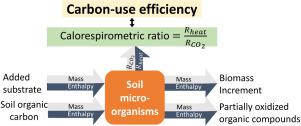Soil Biology and Biochemistry ( IF 9.7 ) Pub Date : 2020-08-03 , DOI: 10.1016/j.soilbio.2020.107945 Arjun Chakrawal , Anke M. Herrmann , Hana Šantrůčková , Stefano Manzoni

|
Microbial carbon use efficiency (CUE) measures the partitioning between anabolic and catabolic processes. While most work on CUE has been based on carbon (C) mass flows, the roles of organic C energy contents and microbial energy demand on CUE have been rarely considered. Thus, a bioenergetics perspective could provide new insights on how microorganisms utilize C and ultimately allow evaluating their role in C stabilization in soils. Recently, the calorespirometric ratio (CR)—the ratio of heat dissipation and respiration—has been used to characterize the efficiency of microbial growth in soils. Here, we formulate a coupled mass and energy balance model for microbial growth and provide a generalized relationship between CUE and CR. In the model, we consider two types of organic C in soils: an added substrate (e.g., glucose) and the native soil organic matter (SOM), to also account for priming effects. Furthermore, we consider both aerobic and fermentation metabolic pathways. We use this model as a framework to generalize previous formulations and generate hypotheses on the expected variations in CR as a function of substrate quality, metabolic pathways, and microbial traits (specifically CUE). In turn, the same equations can be used to estimate CUE from measured CR.
Our results confirm previous findings on CR and show that without microbial growth, CR depends only on the rates of the different metabolic pathways, while CR is also a function of the growth yields for these metabolic pathways when microbial growth occurs. Under strictly aerobic conditions, CUE increases with increasing CR for substrates with a higher degree of reduction than that of the microbial biomass, while CUE decreases with increasing CR for substrates with a lower degree of reduction than the microbial biomass. When aerobic reactions and fermentation occur simultaneously, the relation between CUE and CR is mediated by (i) the degree of reduction of the substrates, (ii) the rates and growth yields of all metabolic pathways, and (iii) the contribution of SOM priming to microbial growth. Using the proposed framework, calorespirometry can be used to evaluate CUE and the role of different metabolic pathways in soil systems.
中文翻译:

使用量热计定量分析土壤中的微生物代谢-生物能学观点
微生物碳利用效率(CUE)衡量合成代谢和分解代谢过程之间的分配。尽管有关CUE的大多数工作都是基于碳(C)的质量流量,但很少考虑有机C能量含量和微生物能量需求对CUE的作用。因此,生物能学的观点可以为微生物如何利用碳提供新的见解,并最终允许评估它们在土壤中碳稳定中的作用。最近,量热呼吸比(CR)(散热和呼吸比)已用于表征土壤中微生物生长的效率。在这里,我们制定了微生物生长的质量和能量平衡耦合模型,并提供了CUE和CR之间的一般关系。在模型中,我们考虑了土壤中的两种有机碳:一种添加的底物(例如,葡萄糖和天然土壤有机质(SOM),也可以考虑引发作用。此外,我们考虑有氧代谢途径和发酵代谢途径。我们使用该模型作为框架来概括以前的公式,并根据底物质量,代谢途径和微生物性状(特别是CUE)对CR的预期变化产生假设。反过来,可以使用相同的方程式从测量的CR估算CUE。
我们的结果证实了先前关于CR的发现,并表明在没有微生物生长的情况下,CR仅取决于不同代谢途径的速率,而当微生物生长时,CR也是这些代谢途径的生长量的函数。在严格有氧条件下,与微生物生物量相比,还原度较高的底物,CUE随CR的增加而增加,而与微生物生物量相比,还原度较低的底物,CUE随CR的增加而降低。当有氧反应和发酵同时发生时,CUE和CR之间的关系由(i)底物的还原程度,(ii)所有代谢途径的速率和生长产量以及(iii)SOM启动引发的作用介导。微生物生长。使用建议的框架,


























 京公网安备 11010802027423号
京公网安备 11010802027423号